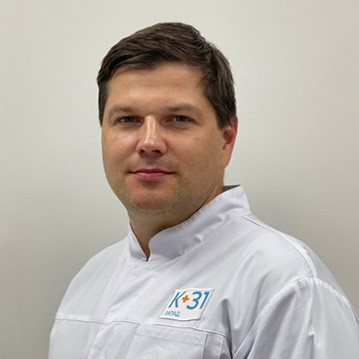Laryngitis

specialists

equipment

treatment

Complications
- Damage to the vocal cords, hoarseness and loss of voice.
- Spread of inflammation through the respiratory tract deep into the body.
- Transition to chronic form.
- Acute oxygen deficiency, suffocation.
Types of laryngitis
Acute laryngitis
Inflammation of the larynx usually does not occur on its own. This is usually facilitated by factors such as:
- Viral/bacterial infections (flu, whooping cough, measles).
- Excessive tension on the vocal cords.
- Inhalation of air contaminated with dust, gases, foreign particles.
- Drinking strong alcohol, which causes larynx irritation.
- Mechanical injuries to the mucous membrane, thermal, chemical burns.
The development of laryngitis due to an allergic reaction is possible. Agents that cause inadequate reactions of the immune system can be food products (milk, citrus fruits, chocolate), insect bites, and components of medications. Allergic laryngitis is dangerous due to rapid swelling of the larynx and often poses a direct threat to life.
Viral laryngitis, like bacterial laryngitis, often acts as a complication of ARVI, bronchitis, pneumonia and other focal inflammations. Additional risk factors are working in unsanitary conditions (in a dusty room), low immune status caused by other chronic pathologies, and long-term use of antibiotics.
Chronic laryngitis
Chronic (recurrent) laryngitis is either a consequence of illiterate and insufficient treatment, or the result of long-term inflammatory diseases of the nasopharynx (rhinitis, sinusitis, tonsillitis). The chronic form often develops in people with many years of smoking experience.
A fairly common form of the disease is chronic hyperplastic laryngitis. This option is characterized by hyperplasia (pathological growth) of mucosal tissue. The larynx of a patient with this diagnosis is constantly enlarged and prone to the rapid development of inflammation. A mild cold, increased strain on the ligaments, eating spicy foods, or the presence of an allergic agent are enough for typical symptoms of laryngitis to occur.
Hyperplastic laryngitis is of two types - diffuse and limited. In the first case, there is a general inflammation of the larynx - hyperemia, thickening, soreness. In the second, nodules of connective tissue appear on the surface of the larynx. These formations interfere with the closure of the vocal cords, which leads to permanent hoarseness.
Pathogenesis and clinical picture

In acute inflammation, the larynx looks red, swollen and painful. The pathological process is most pronounced in the area of the vocal folds. Inflammation can provoke dilation of arteries and capillaries, and this can cause bleeding: with influenza laryngitis, bright red dots appear on the mucous membrane. Isolated laryngitis is characterized by the occurrence of hyperemia (redness) only in the area of the epiglottis.
Intoxication of the body is often accompanied by fever, progressive weakness, pain in muscles and joints. Sometimes acute inflammation spreads not only to the mucous membrane of the larynx, but also to the trachea. This type of disease is called laryngotracheitis.
In acute laryngitis, a reflex involuntary cough may develop. In fact, this is a kind of protective reaction of the body to irritants. A sign of a widespread inflammatory process is a sharp cough accompanied by a sore throat. A persistent cough complicates the course of the disease, injures the mucous membrane and interferes with its recovery. A productive cough with sputum is observed at the final stage of the disease.
Symptoms of laryngitis
The inflammatory process is usually localized in the vocal cords, so manifestations of the disease often cause hoarseness, as well as partial or complete loss of voice. The cough at the onset of the disease is dry and painful, but as the pathology progresses it becomes wet (productive).
Other symptoms of the disease:
- Fever (usually subfebrile).
- Headache, dizziness.
- Weakness, decreased performance, and other signs of general intoxication of the body (this group of symptoms manifests itself especially clearly in bacterial and viral laryngitis).
- Swelling of the larynx, causing difficulty swallowing and breathing.
- Feeling of sore throat.
- Dry mouth.
The chronic form is accompanied by a dry cough, sometimes there is discharge of sputum and streaks of blood. Symptoms: hoarseness, soreness, lump in throat.
Regarding the question of whether laryngitis is contagious or not, it all depends on the nature of the disease. If the disease is caused by viruses, then the pathogens may well be transmitted from a sick person to a healthy person by airborne droplets. Non-infectious forms of laryngitis are not contagious.

Varieties
There are many types of laryngitis. Let's look at the most common of them.
Catarrhal laryngitis is the most common type of disease that responds well to therapy. It manifests itself as a sore throat, hoarseness, and periodic cough. Usually, competent symptomatic therapy is sufficient to eliminate the manifestations and causes of the disease.
Hypertrophic laryngitis - this form is characterized by an intense constant cough and hoarseness of the voice. There is a proliferation of the mucous membrane or the appearance of nodular formations on the vocal cords. This disease develops in people who work with voices (teachers, singers)
Atrophic laryngitis - the mucous membrane becomes thinner during atrophic inflammation, and the patient experiences a dry and painful cough with the separation of blood streaks. Doctors believe that this form of the disease is typical for lovers of overly spicy food.
Diphtheria laryngitis - this laryngitis develops as a result of the penetration of infectious agents into the laryngeal mucosa from the tonsils. The diphtheria form is characterized by the presence of a thin white membrane. The danger is that the film can separate and lead to blockage of the trachea. The appearance of a membrane can be caused by the addition of a staphylococcal infection to the inflammatory process
Tuberculous laryngitis - Tuberculous laryngitis, as the name suggests, is caused by the penetration of microbes from the affected lung tissue into the larynx. This is a dangerous form of the disease that leads to the appearance of nodular growths on the mucous membrane and can lead to the destruction of the laryngeal cartilage and epiglottis
Syphilitic laryngitis is a consequence of progressive syphilis. Accompanied by the appearance of ulcerations and mucous plaques in the larynx. If the underlying pathology progresses to stage 3, scars form on the vocal cords, which subsequently lead to irreversible transformations in voice timbre

How is an appointment with an otolaryngologist at K+31?
Our doctors

This award is given to clinics with the highest ratings according to user ratings, a large number of requests from this site, and in the absence of critical violations.

This award is given to clinics with the highest ratings according to user ratings. It means that the place is known, loved, and definitely worth visiting.

The ProDoctors portal collected 500 thousand reviews, compiled a rating of doctors based on them and awarded the best. We are proud that our doctors are among those awarded.
Make an appointment at a convenient time on the nearest date
Price






























Why do septoplasty?
Laryngitis is an inflammatory pathology of the mucous membrane of the larynx and vocal cords. It is a consequence of colds, overstrain of the larynx, allergies, smoking, and inhalation of dust. The most common provoking factor of inflammation is exposure to infectious agents.
According to the form of the disease, acute and chronic inflammation are distinguished. In the first case, the disease develops quickly, but with proper treatment it does not last longer than 2 weeks. In the second case, symptoms appear longer than 14 days: recurrent laryngitis occurs in people whose work requires constant tension on the vocal cords (singers, coaches, teachers).